Essay on Big Five Personality Traits and Improvement
VerifiedAdded on 2022/09/02
|6
|1345
|20
Essay
AI Summary
This essay provides a comprehensive overview of the Big Five personality traits, a widely recognized model in psychology. It defines the five core traits: openness to experience, conscientiousness, extraversion, agreeableness, and neuroticism, explaining their characteristics and impact on individual behavior. The essay details methods for measuring these traits, primarily through self-assessment questionnaires, and highlights the advantages of understanding one's personality profile, such as improved workplace performance and better self-awareness. Furthermore, it explores the potential for personality trait improvement through targeted training and self-reflection. The essay also references several studies and research papers to support its claims. Ultimately, the essay concludes that understanding and working with the Big Five traits is crucial for personal and professional development, enabling individuals to identify and enhance their strengths while mitigating weaknesses.
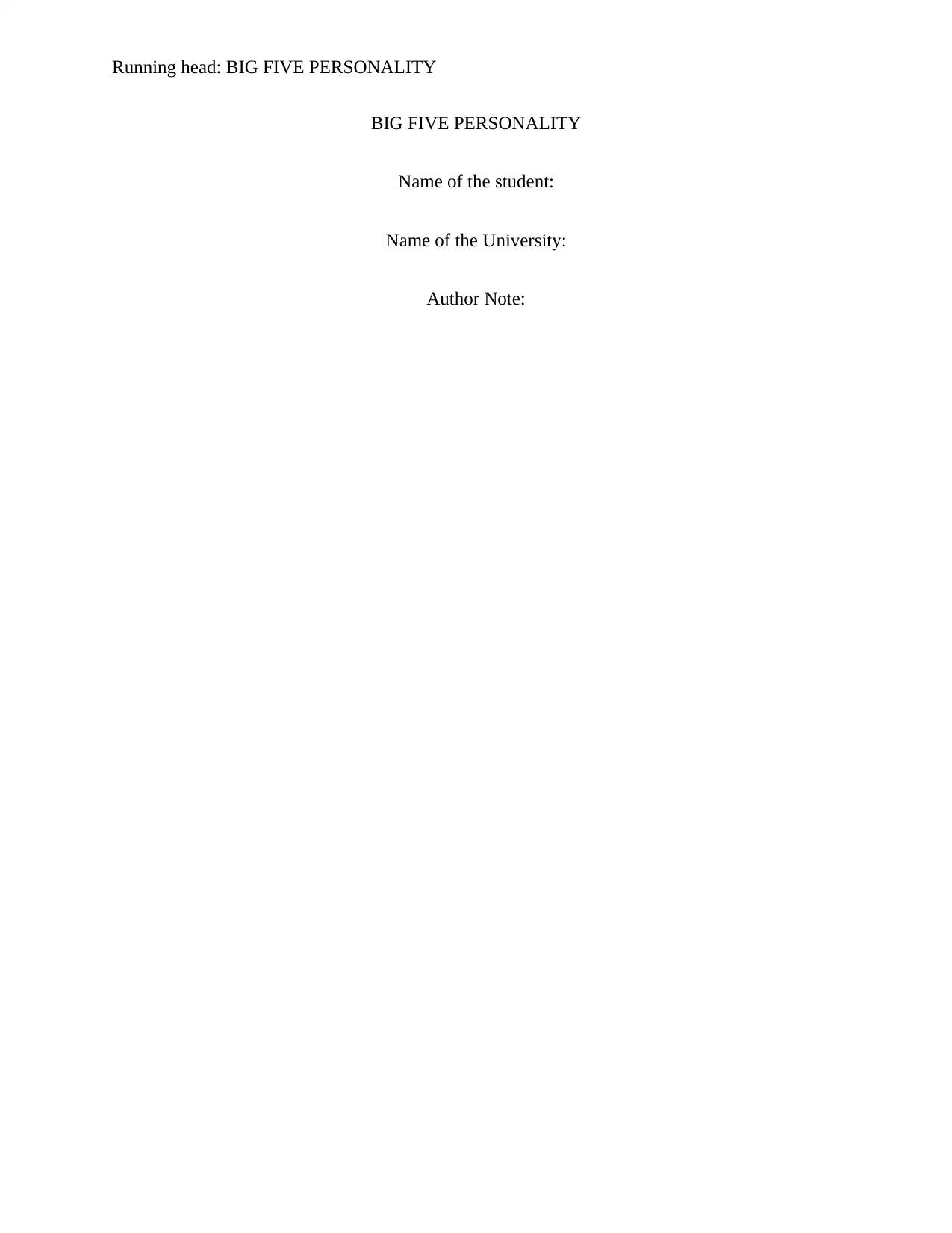
Running head: BIG FIVE PERSONALITY
BIG FIVE PERSONALITY
Name of the student:
Name of the University:
Author Note:
BIG FIVE PERSONALITY
Name of the student:
Name of the University:
Author Note:
Paraphrase This Document
Need a fresh take? Get an instant paraphrase of this document with our AI Paraphraser
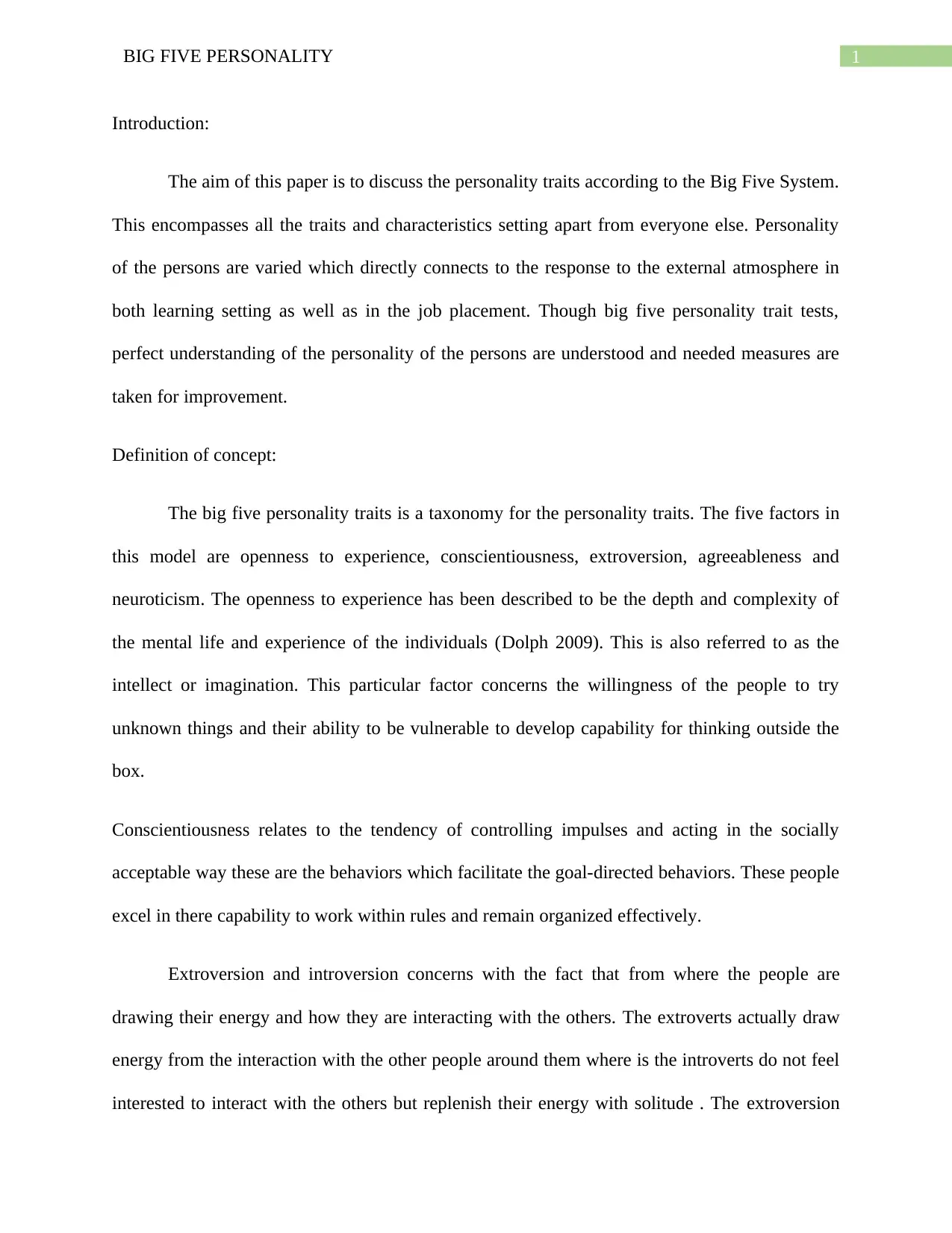
1BIG FIVE PERSONALITY
Introduction:
The aim of this paper is to discuss the personality traits according to the Big Five System.
This encompasses all the traits and characteristics setting apart from everyone else. Personality
of the persons are varied which directly connects to the response to the external atmosphere in
both learning setting as well as in the job placement. Though big five personality trait tests,
perfect understanding of the personality of the persons are understood and needed measures are
taken for improvement.
Definition of concept:
The big five personality traits is a taxonomy for the personality traits. The five factors in
this model are openness to experience, conscientiousness, extroversion, agreeableness and
neuroticism. The openness to experience has been described to be the depth and complexity of
the mental life and experience of the individuals (Dolph 2009). This is also referred to as the
intellect or imagination. This particular factor concerns the willingness of the people to try
unknown things and their ability to be vulnerable to develop capability for thinking outside the
box.
Conscientiousness relates to the tendency of controlling impulses and acting in the socially
acceptable way these are the behaviors which facilitate the goal-directed behaviors. These people
excel in there capability to work within rules and remain organized effectively.
Extroversion and introversion concerns with the fact that from where the people are
drawing their energy and how they are interacting with the others. The extroverts actually draw
energy from the interaction with the other people around them where is the introverts do not feel
interested to interact with the others but replenish their energy with solitude . The extroversion
Introduction:
The aim of this paper is to discuss the personality traits according to the Big Five System.
This encompasses all the traits and characteristics setting apart from everyone else. Personality
of the persons are varied which directly connects to the response to the external atmosphere in
both learning setting as well as in the job placement. Though big five personality trait tests,
perfect understanding of the personality of the persons are understood and needed measures are
taken for improvement.
Definition of concept:
The big five personality traits is a taxonomy for the personality traits. The five factors in
this model are openness to experience, conscientiousness, extroversion, agreeableness and
neuroticism. The openness to experience has been described to be the depth and complexity of
the mental life and experience of the individuals (Dolph 2009). This is also referred to as the
intellect or imagination. This particular factor concerns the willingness of the people to try
unknown things and their ability to be vulnerable to develop capability for thinking outside the
box.
Conscientiousness relates to the tendency of controlling impulses and acting in the socially
acceptable way these are the behaviors which facilitate the goal-directed behaviors. These people
excel in there capability to work within rules and remain organized effectively.
Extroversion and introversion concerns with the fact that from where the people are
drawing their energy and how they are interacting with the others. The extroverts actually draw
energy from the interaction with the other people around them where is the introverts do not feel
interested to interact with the others but replenish their energy with solitude . The extroversion
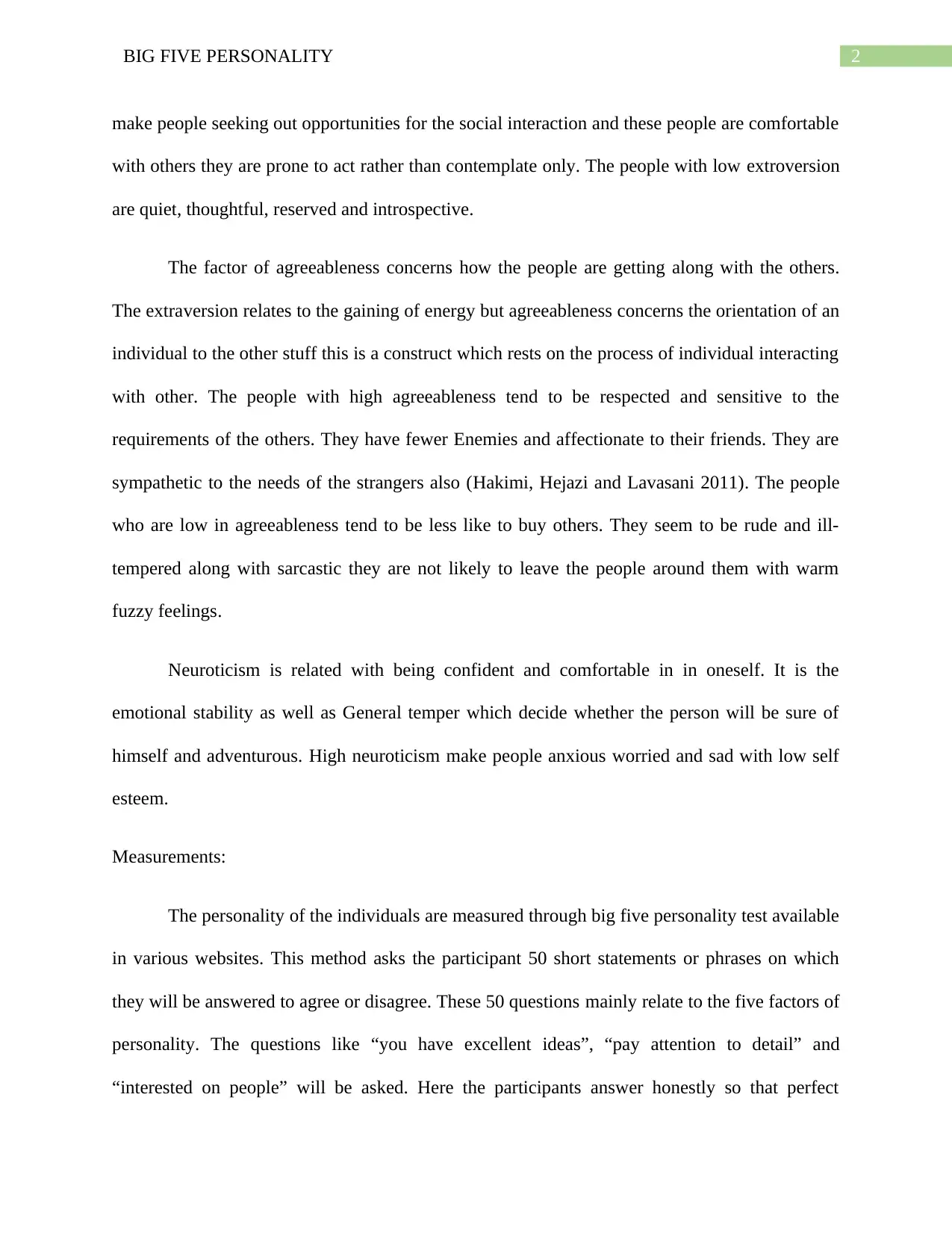
2BIG FIVE PERSONALITY
make people seeking out opportunities for the social interaction and these people are comfortable
with others they are prone to act rather than contemplate only. The people with low extroversion
are quiet, thoughtful, reserved and introspective.
The factor of agreeableness concerns how the people are getting along with the others.
The extraversion relates to the gaining of energy but agreeableness concerns the orientation of an
individual to the other stuff this is a construct which rests on the process of individual interacting
with other. The people with high agreeableness tend to be respected and sensitive to the
requirements of the others. They have fewer Enemies and affectionate to their friends. They are
sympathetic to the needs of the strangers also (Hakimi, Hejazi and Lavasani 2011). The people
who are low in agreeableness tend to be less like to buy others. They seem to be rude and ill-
tempered along with sarcastic they are not likely to leave the people around them with warm
fuzzy feelings.
Neuroticism is related with being confident and comfortable in in oneself. It is the
emotional stability as well as General temper which decide whether the person will be sure of
himself and adventurous. High neuroticism make people anxious worried and sad with low self
esteem.
Measurements:
The personality of the individuals are measured through big five personality test available
in various websites. This method asks the participant 50 short statements or phrases on which
they will be answered to agree or disagree. These 50 questions mainly relate to the five factors of
personality. The questions like “you have excellent ideas”, “pay attention to detail” and
“interested on people” will be asked. Here the participants answer honestly so that perfect
make people seeking out opportunities for the social interaction and these people are comfortable
with others they are prone to act rather than contemplate only. The people with low extroversion
are quiet, thoughtful, reserved and introspective.
The factor of agreeableness concerns how the people are getting along with the others.
The extraversion relates to the gaining of energy but agreeableness concerns the orientation of an
individual to the other stuff this is a construct which rests on the process of individual interacting
with other. The people with high agreeableness tend to be respected and sensitive to the
requirements of the others. They have fewer Enemies and affectionate to their friends. They are
sympathetic to the needs of the strangers also (Hakimi, Hejazi and Lavasani 2011). The people
who are low in agreeableness tend to be less like to buy others. They seem to be rude and ill-
tempered along with sarcastic they are not likely to leave the people around them with warm
fuzzy feelings.
Neuroticism is related with being confident and comfortable in in oneself. It is the
emotional stability as well as General temper which decide whether the person will be sure of
himself and adventurous. High neuroticism make people anxious worried and sad with low self
esteem.
Measurements:
The personality of the individuals are measured through big five personality test available
in various websites. This method asks the participant 50 short statements or phrases on which
they will be answered to agree or disagree. These 50 questions mainly relate to the five factors of
personality. The questions like “you have excellent ideas”, “pay attention to detail” and
“interested on people” will be asked. Here the participants answer honestly so that perfect
⊘ This is a preview!⊘
Do you want full access?
Subscribe today to unlock all pages.

Trusted by 1+ million students worldwide
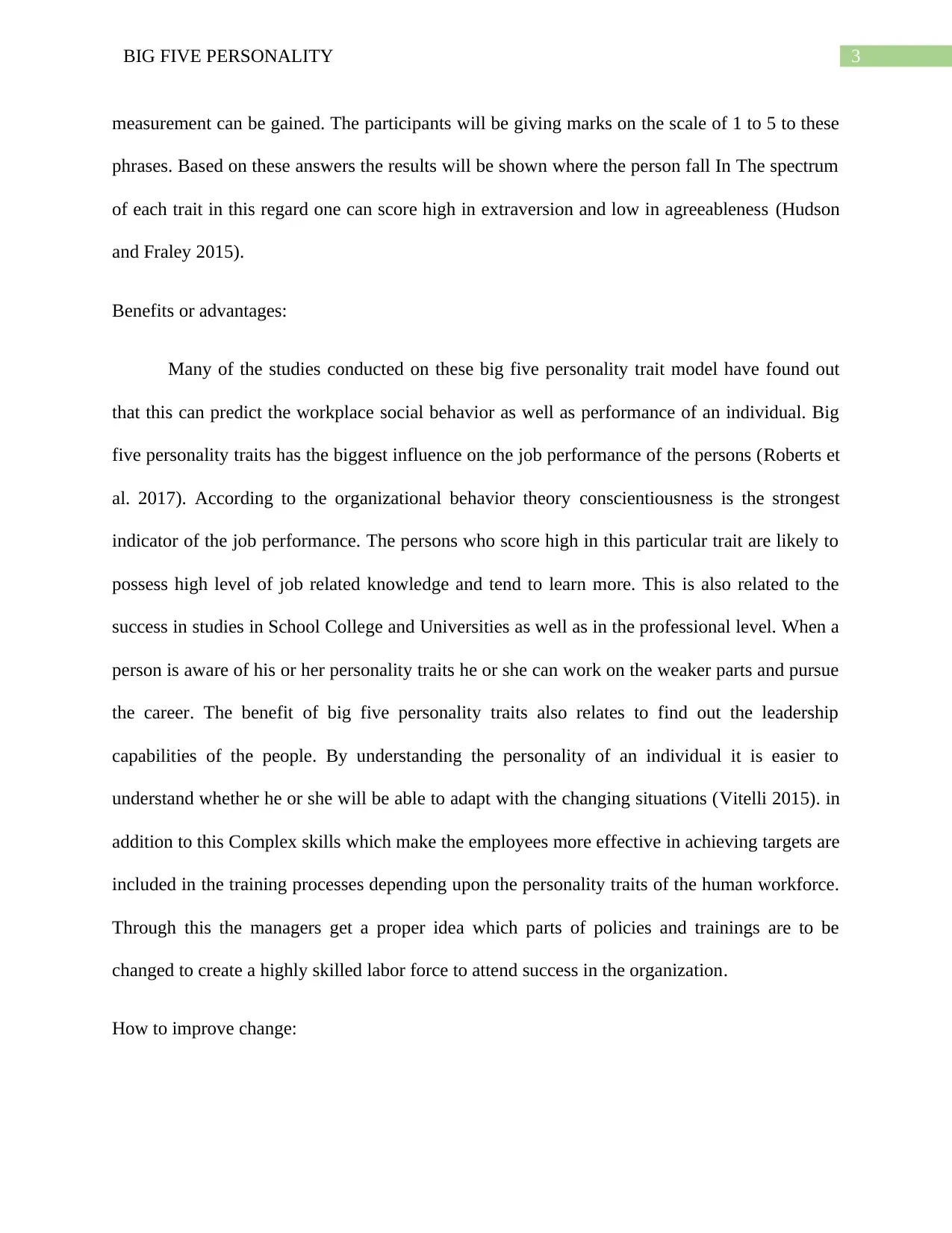
3BIG FIVE PERSONALITY
measurement can be gained. The participants will be giving marks on the scale of 1 to 5 to these
phrases. Based on these answers the results will be shown where the person fall In The spectrum
of each trait in this regard one can score high in extraversion and low in agreeableness (Hudson
and Fraley 2015).
Benefits or advantages:
Many of the studies conducted on these big five personality trait model have found out
that this can predict the workplace social behavior as well as performance of an individual. Big
five personality traits has the biggest influence on the job performance of the persons (Roberts et
al. 2017). According to the organizational behavior theory conscientiousness is the strongest
indicator of the job performance. The persons who score high in this particular trait are likely to
possess high level of job related knowledge and tend to learn more. This is also related to the
success in studies in School College and Universities as well as in the professional level. When a
person is aware of his or her personality traits he or she can work on the weaker parts and pursue
the career. The benefit of big five personality traits also relates to find out the leadership
capabilities of the people. By understanding the personality of an individual it is easier to
understand whether he or she will be able to adapt with the changing situations (Vitelli 2015). in
addition to this Complex skills which make the employees more effective in achieving targets are
included in the training processes depending upon the personality traits of the human workforce.
Through this the managers get a proper idea which parts of policies and trainings are to be
changed to create a highly skilled labor force to attend success in the organization.
How to improve change:
measurement can be gained. The participants will be giving marks on the scale of 1 to 5 to these
phrases. Based on these answers the results will be shown where the person fall In The spectrum
of each trait in this regard one can score high in extraversion and low in agreeableness (Hudson
and Fraley 2015).
Benefits or advantages:
Many of the studies conducted on these big five personality trait model have found out
that this can predict the workplace social behavior as well as performance of an individual. Big
five personality traits has the biggest influence on the job performance of the persons (Roberts et
al. 2017). According to the organizational behavior theory conscientiousness is the strongest
indicator of the job performance. The persons who score high in this particular trait are likely to
possess high level of job related knowledge and tend to learn more. This is also related to the
success in studies in School College and Universities as well as in the professional level. When a
person is aware of his or her personality traits he or she can work on the weaker parts and pursue
the career. The benefit of big five personality traits also relates to find out the leadership
capabilities of the people. By understanding the personality of an individual it is easier to
understand whether he or she will be able to adapt with the changing situations (Vitelli 2015). in
addition to this Complex skills which make the employees more effective in achieving targets are
included in the training processes depending upon the personality traits of the human workforce.
Through this the managers get a proper idea which parts of policies and trainings are to be
changed to create a highly skilled labor force to attend success in the organization.
How to improve change:
Paraphrase This Document
Need a fresh take? Get an instant paraphrase of this document with our AI Paraphraser
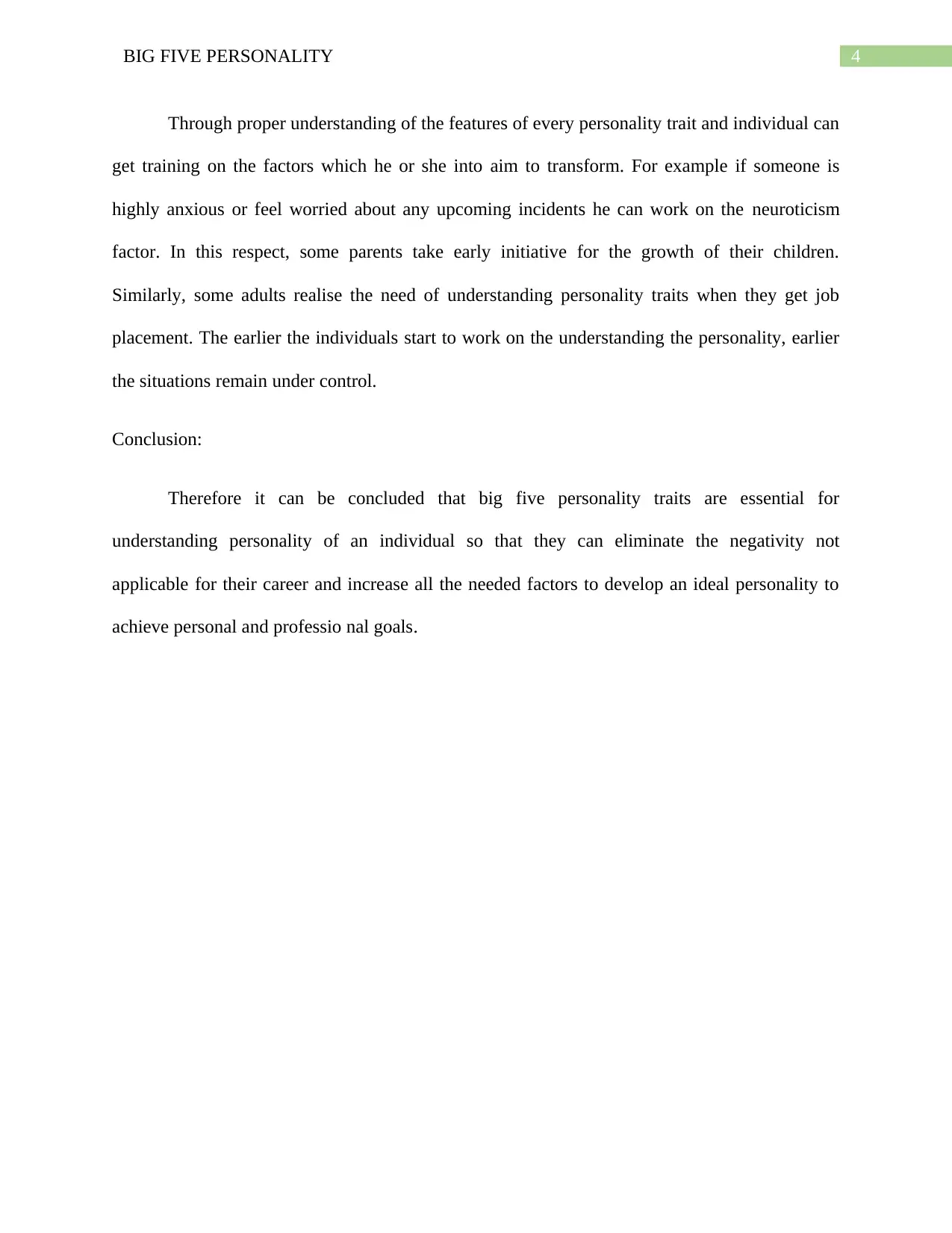
4BIG FIVE PERSONALITY
Through proper understanding of the features of every personality trait and individual can
get training on the factors which he or she into aim to transform. For example if someone is
highly anxious or feel worried about any upcoming incidents he can work on the neuroticism
factor. In this respect, some parents take early initiative for the growth of their children.
Similarly, some adults realise the need of understanding personality traits when they get job
placement. The earlier the individuals start to work on the understanding the personality, earlier
the situations remain under control.
Conclusion:
Therefore it can be concluded that big five personality traits are essential for
understanding personality of an individual so that they can eliminate the negativity not
applicable for their career and increase all the needed factors to develop an ideal personality to
achieve personal and professio nal goals.
Through proper understanding of the features of every personality trait and individual can
get training on the factors which he or she into aim to transform. For example if someone is
highly anxious or feel worried about any upcoming incidents he can work on the neuroticism
factor. In this respect, some parents take early initiative for the growth of their children.
Similarly, some adults realise the need of understanding personality traits when they get job
placement. The earlier the individuals start to work on the understanding the personality, earlier
the situations remain under control.
Conclusion:
Therefore it can be concluded that big five personality traits are essential for
understanding personality of an individual so that they can eliminate the negativity not
applicable for their career and increase all the needed factors to develop an ideal personality to
achieve personal and professio nal goals.
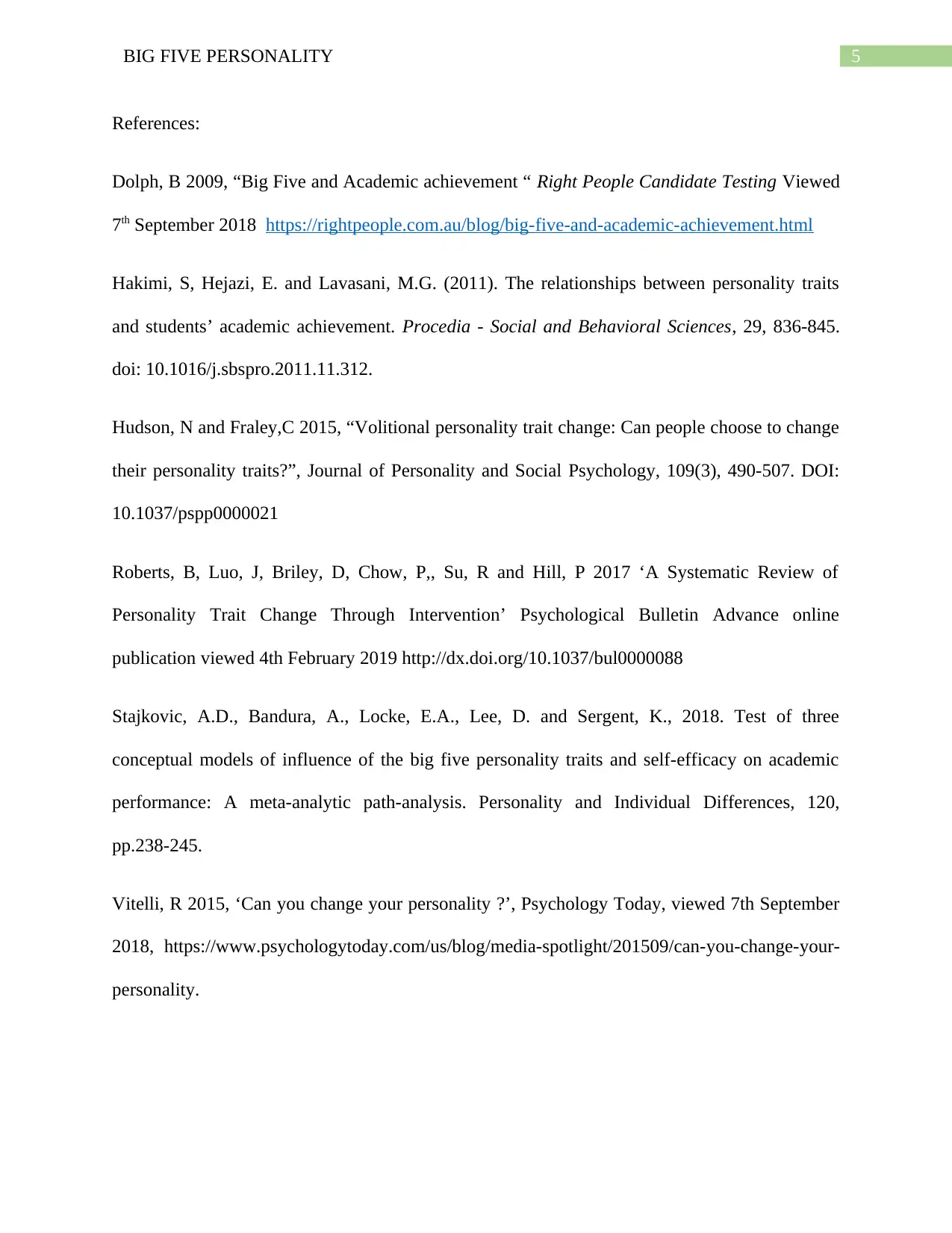
5BIG FIVE PERSONALITY
References:
Dolph, B 2009, “Big Five and Academic achievement “ Right People Candidate Testing Viewed
7th September 2018 https://rightpeople.com.au/blog/big-five-and-academic-achievement.html
Hakimi, S, Hejazi, E. and Lavasani, M.G. (2011). The relationships between personality traits
and students’ academic achievement. Procedia - Social and Behavioral Sciences, 29, 836-845.
doi: 10.1016/j.sbspro.2011.11.312.
Hudson, N and Fraley,C 2015, “Volitional personality trait change: Can people choose to change
their personality traits?”, Journal of Personality and Social Psychology, 109(3), 490-507. DOI:
10.1037/pspp0000021
Roberts, B, Luo, J, Briley, D, Chow, P,, Su, R and Hill, P 2017 ‘A Systematic Review of
Personality Trait Change Through Intervention’ Psychological Bulletin Advance online
publication viewed 4th February 2019 http://dx.doi.org/10.1037/bul0000088
Stajkovic, A.D., Bandura, A., Locke, E.A., Lee, D. and Sergent, K., 2018. Test of three
conceptual models of influence of the big five personality traits and self-efficacy on academic
performance: A meta-analytic path-analysis. Personality and Individual Differences, 120,
pp.238-245.
Vitelli, R 2015, ‘Can you change your personality ?’, Psychology Today, viewed 7th September
2018, https://www.psychologytoday.com/us/blog/media-spotlight/201509/can-you-change-your-
personality.
References:
Dolph, B 2009, “Big Five and Academic achievement “ Right People Candidate Testing Viewed
7th September 2018 https://rightpeople.com.au/blog/big-five-and-academic-achievement.html
Hakimi, S, Hejazi, E. and Lavasani, M.G. (2011). The relationships between personality traits
and students’ academic achievement. Procedia - Social and Behavioral Sciences, 29, 836-845.
doi: 10.1016/j.sbspro.2011.11.312.
Hudson, N and Fraley,C 2015, “Volitional personality trait change: Can people choose to change
their personality traits?”, Journal of Personality and Social Psychology, 109(3), 490-507. DOI:
10.1037/pspp0000021
Roberts, B, Luo, J, Briley, D, Chow, P,, Su, R and Hill, P 2017 ‘A Systematic Review of
Personality Trait Change Through Intervention’ Psychological Bulletin Advance online
publication viewed 4th February 2019 http://dx.doi.org/10.1037/bul0000088
Stajkovic, A.D., Bandura, A., Locke, E.A., Lee, D. and Sergent, K., 2018. Test of three
conceptual models of influence of the big five personality traits and self-efficacy on academic
performance: A meta-analytic path-analysis. Personality and Individual Differences, 120,
pp.238-245.
Vitelli, R 2015, ‘Can you change your personality ?’, Psychology Today, viewed 7th September
2018, https://www.psychologytoday.com/us/blog/media-spotlight/201509/can-you-change-your-
personality.
⊘ This is a preview!⊘
Do you want full access?
Subscribe today to unlock all pages.

Trusted by 1+ million students worldwide
1 out of 6
Related Documents
Your All-in-One AI-Powered Toolkit for Academic Success.
+13062052269
info@desklib.com
Available 24*7 on WhatsApp / Email
![[object Object]](/_next/static/media/star-bottom.7253800d.svg)
Unlock your academic potential
Copyright © 2020–2025 A2Z Services. All Rights Reserved. Developed and managed by ZUCOL.





